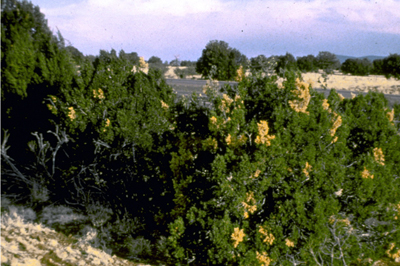Guide H-166
Stephani Sandoval
College of Agricultural, Consumer and Environmental Sciences, New Mexico State University. (Print Friendly PDF)
Author: Forest Health Specialist, Department of Extension Plant Sciences, New Mexico State University.
Background
Juniper twig pruner (Styloxus bicolor) is an insect native to New Mexico that can cause twig dieback during dry periods. The insect also occurs in California, Nevada, Utah, and Arizona, wherever its hosts Juniperus spp. and Cupressus spp. (junipers and cypresses) occur. This insect is more common in forested areas than in the urban landscape, but occasionally there will be problems in the home setting.
Life Cycle
Adults often lay eggs under the bark on branches near the junction of twigs one to two feet back from the branch tip. Small, white, cylindrical larvae kill twigs by boring into them and feeding on the pith (center of the twig). The life cycle of the juniper twig pruner may take up to two years to complete.
Identification
Twigs that experience dieback may develop yellow, red, or brown foliage (Figure 1). Discoloration begins in July after the beetle larvae have mined the pith of the affected twigs. Damage may be mistaken for that caused by adult cedar bark beetles, but the juniper twig pruner creates a distinct, round boring tunnel though the center of each dying twig (Figures 2 and 3). Adult juniper twig pruners have the typical long-horned beetle form—cylindrical, slender, and slightly flattened bodies—and are about 7–11 mm (0.27–0.43 in.) long. They are brownish to black in color with reddish-orange heads. They have narrow, tapered wing covers that only partially cover the abdomen. Larvae are small, white, legless, and cylindrical with round heads. Several of the body segments directly behind the head are somewhat larger in diameter than those following.
Figure 1. Damage on juniper caused by the juniper twig pruner; note brown foliage where dieback has occurred. Photos courtesy of USDA Forest Service, Southwestern Region. (Used with permission.)
Figure 2. Close-up of damage to juniper from the juniper twig pruner where the pith has been mined out of the twig. Photos courtesy of USDA Forest Service, Southwestern Region. (Used with permission.)
Figure 3. Exit hole of juniper twig pruner. Photos courtesy of USDA Forest Service, Southwestern Region. (Used with permission.)
Management
Currently, there are no registered insecticides for control of this insect; no preventative treatments have been developed either. In urban settings, keeping trees properly spaced, protected from physical damage, and appropriately watered can help reduce the chance of an infestation. If an infestation does occur, prune dead or infested branches and discard them to help control populations. Damage from juniper twig pruners is usually only temporary and cosmetic; the insects do not significantly alter the form and density of junipers.
To find more resources for your business, home, or family, visit the College of Agricultural, Consumer and Environmental Sciences on the World Wide Web at pubs.nmsu.edu
Contents of publications may be freely reproduced for educational purposes. All other rights reserved. For permission to use publications for other purposes, contact pubs@nmsu.edu or the authors listed on the publication.
New Mexico State University is an equal opportunity/affirmative action employer and educator. NMSU and the U.S. Department of Agriculture cooperating.
Printed and electronically distributed November 2008, Las Cruces, NM





